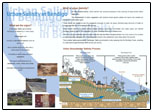Urban Salinity
Buildings and Structures | Road Assets | Vegetation and Earth
Urban salinity causes damage to many natural and built assets including buildings, bridges, pipelines, cemeteries, parks, lakes and waterways. It also affects private homes and gardens.
Urban salinity occurs as a result of a combination of excess water and excess salt in the environment. Our use and management of land and water resources has a large impact on urban salinity.
As with dryland salinity, urban salinity occurs when deep-rooted native vegetation is cleared and the replacement system transpires much less water. This creates an imbalance in the water cycle, with increased amounts of water escaping past the root zone and into the underlying groundwater (referred to as 'groundwater recharge'). The installation of roads, buildings and other infrastructure also alters natural drainage patterns, while other sources of excess water may result from leaking sewerage, stormwater and water pipes.
Over time, the groundwater system can fill and bring dissolved salts from weathered rocks deep below the surface and from other sources. Salt is naturally present in soil, groundwater, waterways and rain. Additional (very minor) sources of salt in urban environments include effluent (household and industrial), swimming pools, fertilisers, soap and detergents, and building materials.
Where saline groundwater comes within about 1.5 metres of the soil surface, it is drawn up by capillary action to form 'saline groundwater discharge' sites. These sites most often occur in low areas of the landscape.
Whilst the causes are somewhat similar in most areas, the processes vary from region to region according to differences in geology, landform and climate. This is because groundwater flow is also important. Groundwater generally flows from positions high in the landscape to positions lower in the landscape. Water escaping the root zone in one area of the city may, for example, contribute to salinity occurring in another area of the city much further down the catchment.
The capacity for groundwater to flow below the surface depends on the nature of the geological material that the water must flow through. Where this is very porous and permeable, groundwater may flow freely down the catchment over large distances, ultimately discharging in the lowermost part of the landscape (along creeks and valley floors). On the other hand, where geological materials restrict water movement, flow may occur over relatively short distances, with salinity discharge occurring in close proximity to salinity recharge.
An example of urban salinity – Bendigo, Victoria
Beneath the city of Bendigo groundwater moves through open fractures occurring within the upper 50 to 100 metres of the ancient marine sandstones and shales that comprise the region. In some instances, flow also occurs via numerous underground tunnels created by extensive historical underground gold mining activities. The network of fractured rock and tunnels forms a large groundwater system that operates throughout most of the urban area.
The central Victorian City of Bendigo has been experiencing salinity problems since the 1980’s. As for many areas in Australia, it took time to realise that salinity was not only a problem in the rural areas, but also for the local urban community.
Following a long-term salinity education program in Bendigo, an Infrastructure Benchmarking Project was developed in 2003 by Sinclair Knight Merz (SKM) (external link), Phil Dyson and Associates, the former Victorian Department of Primary Industries (DPI) and the City of Greater Bendigo (external link) under the revised North Central Dryland Salinity Management Plan.
This brochure provides a general overview of urban salinity in Bendigo.
 | Urban Salinity in Bendigo (PDF 775KB) To view the information PDF requires the use of a PDF reader. This can be installed for free from the Adobe website (external link). |
References
Collings A (2002). ‘Indicators of Urban Salinity’. NSW Department of Land and Water Conservation, Sydney, New South Wales. ISBN: 07347 5276 9.
Ryan M (2003). ‘Introduction to Urban Salinity’. NSW Department of Infrastructure, Planning and Natural Resources, Sydney, New South Wales. ISBN: 0 7347 5376 4.


